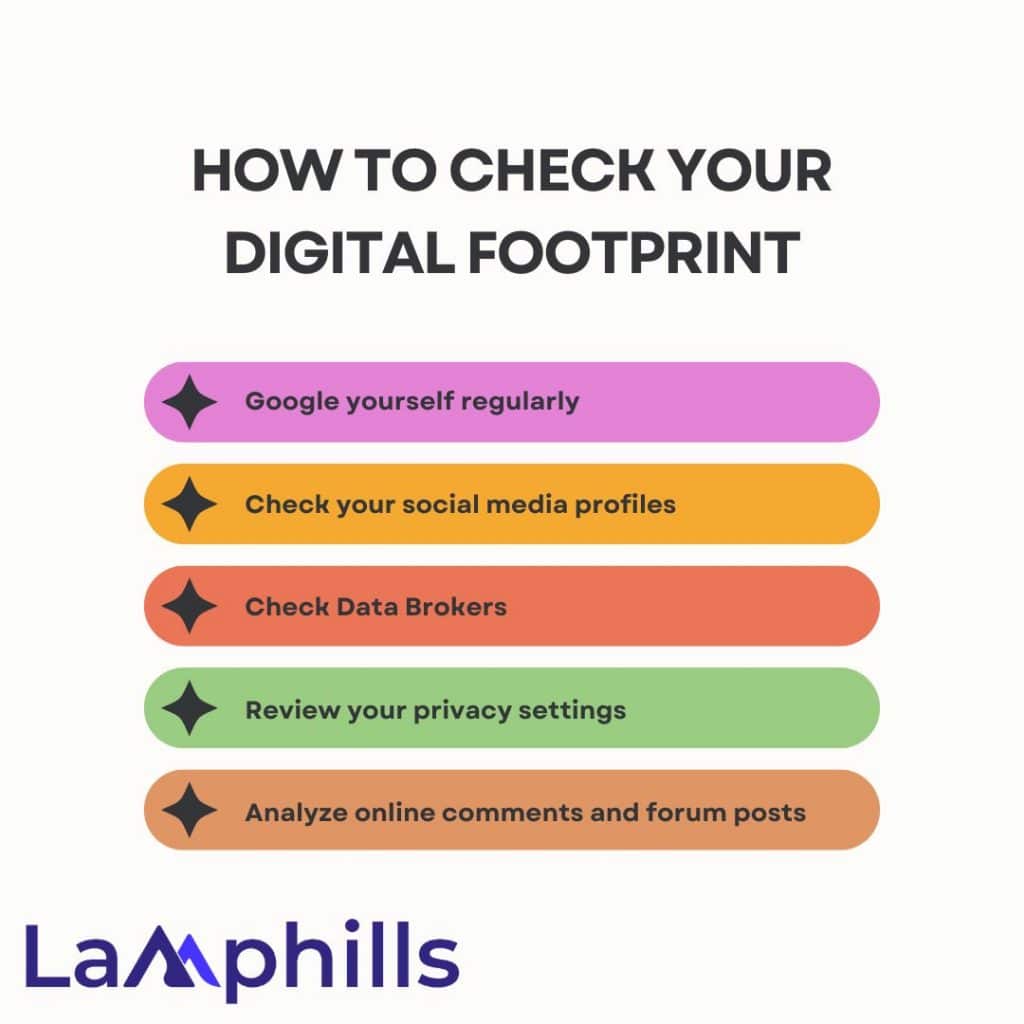Do you recall the first time you Googled your name? I do. My late-night curiosity led me down a rabbit hole of old social media profiles, out-of-date blog entries, and weird remarks on forums I barely remembered reading. That was when I learned the full scope of my digital footprint. As a professional in today’s interconnected world, recognizing and controlling your digital footprint is about more than just vanity; it’s about protecting your reputation and career. This article goes further than a simple Google search. We’ll look at how to check and manage your digital footprint, allowing you to create a favorable and professional online profile.
What is a Digital Footprint?
Your digital footprint consists of personal data traces that you leave behind whenever you connect to the internet. Leaving a digital footprint is a feature of modern life. This, however, does not imply that we should leave behind needless data that may expose us to digital threats. Minimize your online dangers by leaving a modest digital footprint.
Key Takeaways
- Your digital footprint includes all the personal data traces you leave online, and managing it is crucial for protecting your reputation and career in today’s interconnected world.
- A professional’s digital footprint is more than a collection of online activities; it reflects their personal and professional identity, impacting how employers, clients, and colleagues perceive them.
- Monitoring your digital footprint helps maintain a strong online reputation and protects personal information from potential cyber threats and identity theft.
- Besides basic checks like Google searches and social media audits, it’s essential to consider hidden aspects of your digital footprint, such as third-party app access, email tracking, and public records.
Why Does Your Digital Footprint Matter?
A professional’s digital footprint is more than just a collection of online actions. It reflects your personal and professional identity. Employers, clients, and colleagues frequently use online searches to learn more about you. A single incorrect post or out-of-date information can damage your reputation. According to CareerBuilder, 70% of employers use social media to vet candidates throughout the hiring process, and almost half check in on the digital footprint of the current employees online.
Why Monitoring Your Digital Footprint Is Important
Keeping track of your digital footprint is essential for keeping a strong online reputation and preserving personal information. When information is left unmonitored or easily accessible online, the chance of identity theft or damage increases.
Cybercriminals can potentially exploit any information posted online for a variety of reasons. This knowledge is easily accessible if it is presented openly.
Aside from cybercriminals, individuals may pose the greatest hazard to themselves online. Employers, universities, and other professional higher-ups frequently conduct a simple search on a person’s name or email address to learn a great deal about the subject at hand in the modern world. This has resulted in the loss of jobs, scholarships, possible roles, and other opportunities on multiple occasions. In fact, researching someone’s digital footprint before hiring them has become fairly standard practice in most businesses.
Types of Digital Footprints
#1. Passive Digital Footprint
A passive digital footprint is information gathered without the user providing any data. This would include items like log files and browser cookies. Typically, this data is utilized to improve the user experience by remembering preferences and behaviors.
#2. Active Digital Footprint
When individuals intentionally share information online, such as publishing updates on social media, they leave an active digital footprint. This footprint is made up of data that is purposefully shared, such as social media postings, emails, and uploaded documents. Other factors that contribute to an active digital footprint include comments, online purchases, and the use of specific programs.
How To Check Your Digital Footprint

#1. Google yourself regularly
Begin with the basics. Google your name and see what comes up. Use variations of your name and any nicknames. Remember to check the image and video search results as well. This initial search will provide you with an overview of your web presence.
#2. Check your social media profiles
Examine your social media profiles on platforms such as LinkedIn, Facebook, Twitter, and Instagram. Check for outdated postings, images, or remarks that no longer reflect your current professional image. According to a Statista poll, 54% of social media users have changed their privacy settings to limit who may view their information.
#3. Check Data Brokers
Data brokers such as Spokeo, Whitepages, and MyLife acquire and sell personal information. These websites frequently keep profiles on you without your permission. Use apps like DeleteMe or Privacy Bee to locate and remove your personal information from these databases.
#4. Review your privacy settings
Make sure your privacy settings on all social media sites and online accounts are set to your preferred level. This step is critical for controlling who can view your information and posts. Facebook, for example, has a detailed privacy checkup tool that may help you modify your settings.
#5. Analyze online comments and forum posts
Don’t overlook the comments you’ve posted on news stories, blogs, and forums. Use search engines to find these by entering your name and any previous usernames. Delete or amend these comments if they no longer reflect your opinions or professionalism.
Hidden Aspects of Your Digital Footprint.
Most articles finish with social media audits and Google searches, but your digital footprint goes beyond them. Here are some lesser-known features to consider:
#1. Third-Party App Access
How many apps do you allow access to your social media or email accounts? Over time, we connect multiple apps for convenience, but we frequently forget about them. These apps might continue to access your data even after you stop using them. Regularly examine and revoke access to third-party apps that you no longer use.
#2. Email Tracking
Did you know that marketing emails frequently include trackers that tell the sender when and where you accessed the message? Tools like PixelBlock and Mailtrack can assist you in identifying and blocking these trackers, giving you greater control over your email privacy.
#3. Public Records
Some of your information, such as property records, court documents, and business filings, may be available online via public records databases. Regularly review them and correct any inaccuracies.
I once came across an old, forgotten blog I established in college, full of poorly written entries and teenage ranting. It was embarrassing, to say the least, especially because potential clients could easily locate it. I spent hours deleting posts and improving my digital presence. This incident showed me the value of ongoing digital maintenance. It is not a one-time effort, but rather a continuous process.
The Personal Branding Audit Template
While finding hidden information is critical, so is maintaining a smart internet presence. The Personal Branding Audit Template will help you assess your current digital footprint and discover areas for development. Here’s how.
- List your online profiles: Make a list of all your social media accounts, professional websites, and any other online platforms where your information may appear.
- Evaluate content: Examine the stuff you’ve shared across these channels. To increase discoverability, update obsolete material, eliminate irrelevant content, and optimize with important keywords to reflect your desired professional image.
Using the Personal Branding Audit Template, you can find opportunities to improve your digital footprint and create a unified online presence that matches your professional identity.
How To Remove Your Digital Footprint
Deleting your digital footprint is very hard because any online action you engage in has traces of information linked to you already saved by third-party businesses, the government, or other groups. You can, however, decrease your digital footprint and the information that is publicly available about you. Here’s how.
- Log in to your Facebook, Instagram, TikTok, Twitter, YouTube, or any other social media account for which you have a profile. This also applies to your email accounts and any other online accounts that store your personal information.
- Delete any unneeded information that you do not want the website or service to store. This includes your home address, phone number, and birthdate.
- Delete any postings, images, or videos you no longer want to be linked with.
- Consider removing any accounts you are no longer utilizing.
- Check the privacy settings for all of your internet accounts. Limit the quantity of data collected and shared.
Tips for Protecting Your Digital Footprint
Maintaining anonymity online can be difficult; here are some best practices from our Security Experts to help safeguard your online identity:
- Avoid oversharing on social media platforms or public forums. Unless absolutely required, do not give personally identifiable information such as your home address, phone number, or date of birth.
- When registering for other online services that require personal information, use a different email address or a pseudonym.
- When surfing the internet, use a private browser or a VPN to avoid third-party services from tracking your behavior.
- Remove any data from your device regularly. Clear your browser’s history, cache, and cookies.
Reducing Your Digital Footprint
Overall, there is no ideal answer for eliminating your digital footprint. Not all information is posted or withdrawn uniformly. To begin, find up which websites your email is affiliated with. Where did you sign up? Which mailing letters are you a part of? Once you’ve located these sites, you can either log back in and delete the account or contact customer service and request that the account be removed.
To be more comprehensive with your efforts, we recommend choosing one of the following:
- Google Results About You: is a Google portal for finding pages that include your information. They do ask you to fill out a short form, but the rest is pretty automated – Google/resultsaboutyou. ‘;- Have I been pwned? – Have I been Pwned? is a useful resource for determining which websites have compromised your information.
- Intel Techniques: Intel Techniques is a website full of various guidelines and resources that can be quite valuable for people looking to lessen their digital footprint. Tools like phone number search and address searches are especially useful.
Lamphills: Your Partner in Building a Powerful Digital Footprint
Lamphills Media understands the value of a strategic digital footprint. We provide a variety of services to help you manage and optimize your online presence, including:
Social media auditing and strategy development: We can help you assess your present social media presence and devise a strategy to meet your professional objectives.
- Content development and curation: Our team generates high-quality material to highlight your expertise and position you as a thought leader in your sector.
- Online reputation management: We assist you in monitoring your online reputation and addressing any unfavorable content that may appear.
With a proactive approach to maintaining your digital footprint, you can build a favorable online presence that attracts prospects and propels your career forward. So, are you ready to take control of your digital narrative? What efforts will you take to find and optimize your digital footprint? Share your ideas in the comments below!
Related Articles
- How To Check A Company’s Reputation in 2024 (Simplified)
- The Top 2024 Brand Mention Tools (All You Need)
- 9 Personal Branding Hacks for Insane Growth in 2024
- How To Write A Personal Brand Statement Defines Your Professional Journey (With Free Templates)






